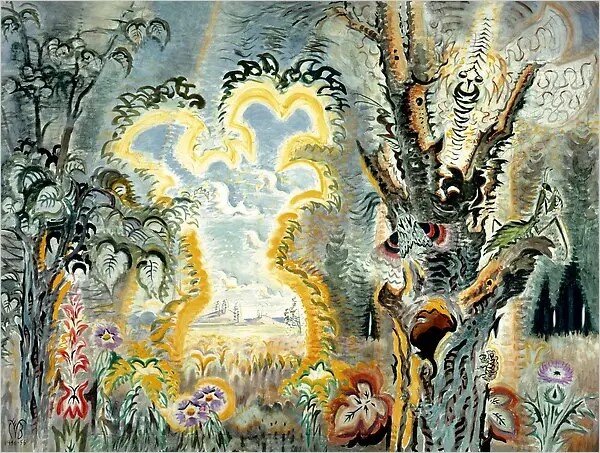Charles E. Burchfield (1893-1967)
Gateway to September, 1945-1956
watercolor on joined paper
42 1/2 x 56 inches
Hunter Museum of American Art, Chattanooga, Tennessee, Gift of the Benwood Foundation.
Charles Burchfield - written by Noel Madrid
I first encountered Charles Burchfield’s work at a retrospective “Heat Waves in a Swamp” on view at the Hammer Museum. I was wrapped in academia at the time, absorbed in studies of classical painting technique as well as discussions on post-modernist conceptual work; the grey area in between seemed immense. Like shark infested waters, the artworld was a deadly serious topic. Looking at Burchfield’s work it was as if something clicked into place, a pressure valve had opened as I marveled at the paintings for their simultaneous complexity and playfulness. Here was a painter who lived through his work and was not defined by the era in which he lived.
Looking at Burchfield's long history of work, there is diligence and duty to his craft. The exuberance and playful use of color in Burchfield's paintings belies his skill as a draftsman. His mountainous body of work is underpinned by an even larger collection of journals and sketchbooks. There is careful composition in his early landscapes, impeccable precision at play in his work as a wallpaper designer. In his drawings and journals I saw a kindred spirit, using pen and paper to develop a perspective that can only come from practiced looking.
In Burchfield’s later monumental watercolors, there is no inkling of complacency. I am still in awe of these later works, they defy the conventions of their medium. The compositions grow from smaller works; Burchfield editing and adding paper as the paintings exceed their boundaries. The paper is well-worked, taped and patched; the watercolor used directly or allowed to mix in sometimes ungainly ways. They resemble hard-won oil paintings more than traditional watercolors, wrestled and pushed to the brink before being dragged to resolution. Light, life, sound and temperature are given physicality in the form of energy emanating from known shapes of trees and buildings. Meditating on these works I feel a sense of humility in the face of the sublime. The result of this is painting that conveys a near spiritual ecstasy, a state that I’m sure was shared by Burchfield himself in the making.

